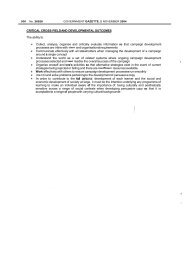The trafficking of children for purposes of sexual exploitation
The trafficking of children for purposes of sexual exploitation
The trafficking of children for purposes of sexual exploitation
You also want an ePaper? Increase the reach of your titles
YUMPU automatically turns print PDFs into web optimized ePapers that Google loves.
Little is known about the gang leader. Interviews reveal that he tried to live up to his image as a<br />
monster. <strong>The</strong> girls speak <strong>of</strong> his brutality in relation to them and the boys in the gang. Little is known<br />
about his connections to other gangs, except that he had connections with the Hard Livings gang.<br />
<strong>The</strong> gang leader is connected to a number <strong>of</strong> residential areas in Cape Town, most notably Salt<br />
River, Woodstock, the Bo-Kaap and Lentegeur in Mitchell's Plain and exercises some influence on<br />
residents in these areas. 146<br />
It is conceivable that his initial job as a pimp is the consequence <strong>of</strong> his last stay in Pollsmoor prison,<br />
from where he was released in 1993. And it is probably here that he became a member <strong>of</strong> the<br />
28s/26s. His role as pimp <strong>of</strong> a small group <strong>of</strong> girls appears to have started at the end <strong>of</strong> 1993.<br />
Douglas-Hamilton points out that theoretically the 26s steal with cunning and the 28s are primarily<br />
concerned with organising <strong>sexual</strong> partners and sodomising. 147<br />
3.2.1.2. Male Gang Members: Known as the Boys/the Guards/Guardtjies<br />
According to Douglas-Hamilton coloured male youths between the ages <strong>of</strong> 13 - 19 years provide<br />
the most useful study group <strong>for</strong> the investigator <strong>of</strong> gang behaviour as "<strong>The</strong> majority <strong>of</strong> gangs youths<br />
fall into this age, sex and race group. 148<br />
Table 4 below reflects this trend. <strong>The</strong> two who fall outside it are the gang leader, and one other<br />
member. Both are over 30. Fourteen <strong>of</strong> the male members represented in this table, are coloured and<br />
one Indian.<br />
This particular gang reflects high family involvement. <strong>The</strong> gang leader seems to draw on his<br />
immediate and extended family <strong>for</strong> recruitment <strong>of</strong> boys. 149 Of the thirteen boys, six are related to<br />
him.<br />
<strong>The</strong> reason <strong>for</strong> the family involvement as well as the girls' taking on the gang leader's surname, in<br />
public spaces indicates that this is a mafia type gang - one type <strong>of</strong> gang organisation found on the<br />
Cape Flats. 150<br />
In some cases, the non-related boys are <strong>children</strong> who used to live on the street. It is not known how<br />
they became members <strong>of</strong> the gang. 151 <strong>The</strong> boys' roles appear to have been to<br />
• protect the girls from sex exploiters, on the street and in the house<br />
• help bring the girls in line, through beatings and <strong>sexual</strong> assaults<br />
• participate in the abduction <strong>of</strong> girls<br />
• lure girls into the gang<br />
• subjugate abducted girls through rape and beatings<br />
• take possession <strong>of</strong> goods stolen by the girls, on the street or in the house.<br />
Table 4: Male gang members - Relationships and reported <strong>of</strong>fences committed against girls 152<br />
Name Relationship to Age in 2000 (some Mentioned by girls in relation to<br />
gang leader might<br />
be <strong>of</strong>fences against them and others<br />
inaccurate)<br />
Boy 1 N/A 17 Physical assault<br />
146 Researchers field notes.<br />
147 D. Douglas-Hamilton: Warriors <strong>of</strong> the Ghetto: Ganging as a rite <strong>of</strong> passage. Dissertation submitted in partial<br />
fulfilment <strong>of</strong> the requirements <strong>for</strong> B SOC SC (HONS) Degree in Criminology, UCT, 1998. p. 57<br />
148 D. Douglas-Hamilton Ibid p.14<br />
149 Interview with police <strong>of</strong>ficer<br />
150 Types <strong>of</strong> gangs are: corner kids, street gangs, mafia, prison and syndicate<br />
151 Interview with police <strong>of</strong>ficer.<br />
152 From interviews with abducted and trafficked girls and their family members<br />
49
















